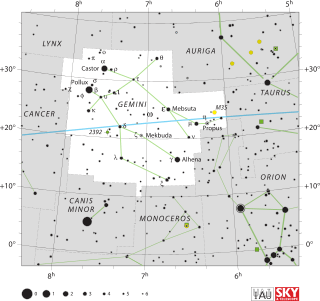Mu Geminorum

| |
| Observation data Epoch J2000.0 Equinox J2000.0 (ICRS) | |
|---|---|
| Constellation | Gemini |
| Right ascension | 06h 22m 57.62686s[1] |
| Declination | +22° 30′ 48.8979″[1] |
| Apparent magnitude (V) | 2.857[2] |
| Characteristics | |
| Spectral type | M3 III[3] |
| B−V color index | +1.643[2] |
| Variable type | LB[4] |
| Astrometry | |
| Radial velocity (Rv) | +54.38 ± 0.24[5] km/s |
| Proper motion (μ) | RA: +56.39[1] mas/yr Dec.: –110.03[1] mas/yr |
| Parallax (π) | 14.08 ± 0.71[1] mas |
| Distance | 230 ± 10 ly (71 ± 4 pc) |
| Details | |
| Mass | 2.1[6] M☉ |
| Luminosity | 2,799[7] L☉ |
| Surface gravity (log g) | 1.50[7] cgs |
| Temperature | 3,773[7] K |
| Rotational velocity (v sin i) | 8.4[8] km/s |
| Other designations | |

Mu Geminorum (μ Gem, μ Geminorum) is the Bayer designation for a star in the northern constellation of Gemini. It has the traditional name Tejat Posterior, which means back foot, because it is the foot of Castor, one of the Gemini twins. This name was formerly applied to an asterism consisting of this star, along with γ Gem (Alhena), ν Gem, η Gem (Tejat Prior), and ξ Gem (Alzirr). The names Calx (Latin, meaning heel), Pish Pai (from the Persian Pīshpāy, پیشپای, meaning foreleg), and Nuhatai (from Arabic Al Nuḥātai, the dual form of Al Nuḥāt, "a Camel's Hump") have also been applied to Mu Geminorum.[9][10][12]
In Chinese, 井宿 (Jǐng Su), meaning Well (asterism), refers to an asterism consisting of μ Geminorum, γ Geminorum, ν Geminorum, ξ Geminorum, ε Geminorum, 36 Geminorum, ζ Geminorum and λ Geminorum.[13] Consequently, μ Geminorum itself is known as 井宿一 (Jǐng Su yī, English: the First Star of Well.)[14]
Properties
Mu Geminorum has an average apparent visual magnitude of 2.9,[2] which makes it the fourth-brightest member of Gemini. From parallax measurements made during the Hipparcos mission, the distance to this star is roughly 230 light-years (71 parsecs).[1] Its visual magnitude is diminished by 0.07 as a result of extinction from intervening gas and dust.[5]
This star is a slow irregular variable of type LB. Its brightness varies between magnitude +2.75 and +3.02 over a 72-day period, along with a 2,000-day period of long term variation. It is a red giant at a stellar classification of M3 III,[3] with a surface temperature of 3,773 K,[7] meaning it is brighter, yet cooler, than the Sun.[4][9] The star is currently on the asymptotic giant branch and is generating energy through the nuclear fusion of hydrogen and helium along concentric shells surrounding an inert core of carbon and oxygen.[15]
References
- 1 2 3 4 5 6 van Leeuwen, F. (November 2007), "Validation of the new Hipparcos reduction", Astronomy and Astrophysics, 474 (2): 653–664, arXiv:0708.1752
 , Bibcode:2007A&A...474..653V, doi:10.1051/0004-6361:20078357.
, Bibcode:2007A&A...474..653V, doi:10.1051/0004-6361:20078357. - 1 2 3 Gutierrez-Moreno, Adelina; et al. (1966), A System of photometric standards, 1, Publicaciones Universidad de Chile, Department de Astronomy, pp. 1–17, Bibcode:1966PDAUC...1....1G.
- 1 2 Morgan, W. W.; Keenan, P. C. (1973), "Spectral Classification", Annual Review of Astronomy and Astrophysics, 11: 29, Bibcode:1973ARA&A..11...29M, doi:10.1146/annurev.aa.11.090173.000333.
- 1 2 mu Gem, entry in the Combined General Catalog of Variable Stars (GCVS4.2), N. N. Samus, O. V. Durlevich, et al., database identifier II/250 at the Centre de Données astronomiques de Strasbourg.
- 1 2 Famaey, B.; et al. (January 2005), "Local kinematics of K and M giants from CORAVEL/Hipparcos/Tycho-2 data. Revisiting the concept of superclusters", Astronomy and Astrophysics, 430 (1): 165–186, arXiv:astro-ph/0409579
 , Bibcode:2005A&A...430..165F, doi:10.1051/0004-6361:20041272.
, Bibcode:2005A&A...430..165F, doi:10.1051/0004-6361:20041272. - ↑ Tsuji, Takashi (May 2007), "Isotopic abundances of Carbon and Oxygen in Oxygen-rich giant stars", in Kupka, F.; Roxburgh, I.; Chan, K., Convection in Astrophysics, Proceedings of IAU Symposium #239 held 21-25 August, 2006 in Prague, Czech Republic, pp. 307–310, arXiv:astro-ph/0610180
 , Bibcode:2007IAUS..239..307T, doi:10.1017/S1743921307000622.
, Bibcode:2007IAUS..239..307T, doi:10.1017/S1743921307000622. - 1 2 3 4 Mallik, Sushma V. (December 1999), "Lithium abundance and mass", Astronomy and Astrophysics, 352: 495–507, Bibcode:1999A&A...352..495M.
- ↑ Massarotti, Alessandro; et al. (January 2008), "Rotational and Radial Velocities for a Sample of 761 HIPPARCOS Giants and the Role of Binarity", The Astronomical Journal, 135 (1): 209–231, Bibcode:2008AJ....135..209M, doi:10.1088/0004-6256/135/1/209.
- 1 2 3 Mu Geminorum at Jim Kaler's STARS.
- 1 2 Allen, Richard Hinckley (1899), Star-names and Their Meanings, G. E. Stechert, p. 236
- ↑ "mu. Gem -- Pulsating variable Star", Simbad Astronomical Object Database, Centre de Données astronomiques de Strasbourg, retrieved October 12, 2007.
- ↑ Astronomers Predict Eclipse of Naked-Eye Star by an Asteroid Monday Morning, Nov. 20 at Spaceref.com.
- ↑ (Chinese) 中國星座神話, written by 陳久金. Published by 台灣書房出版有限公司, 2005, ISBN 978-986-7332-25-7.
- ↑ (Chinese) 香港太空館 - 研究資源 - 亮星中英對照表, Hong Kong Space Museum. Accessed on line November 23, 2010.
- ↑ Lebzelter, T.; Hron, J. (January 2008), "BRITE stars on the AGB", Communications in Asteroseismology, 152: 178–181, Bibcode:2008CoAst.152..178L, doi:10.1553/cia152s178.
